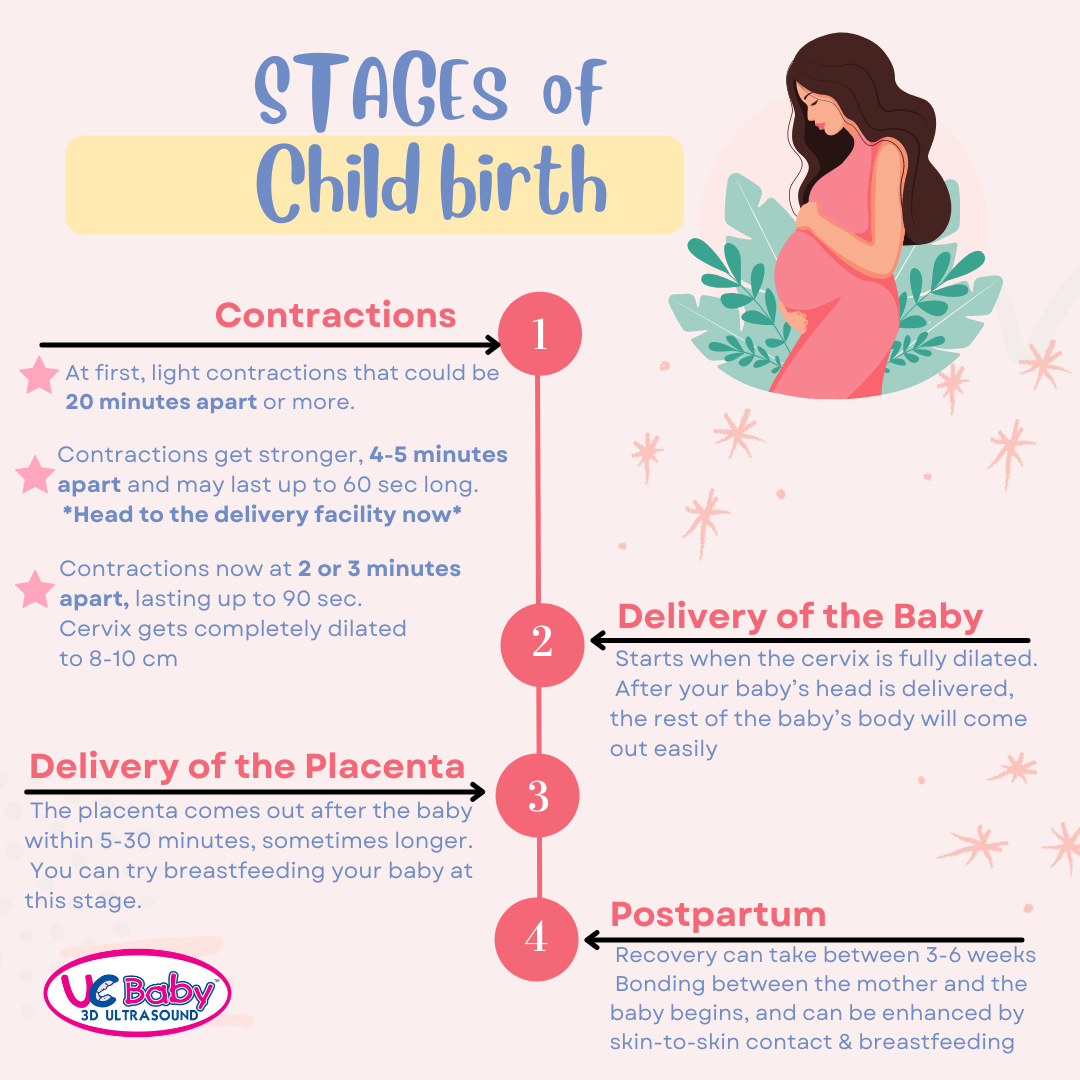Childbirth, also known as labor or parturition, is a natural process through which a baby is brought into the world. It is an incredible journey that every woman experiences in her unique way.
While there are common stages and phases of childbirth, each woman’s experience can vary greatly. The first stage of labour, which is often the longest, consists of three distinct phases: early labour, active labour, and the transitional phase. There are many variations to the experience. As a rule, the first pregnancy’s labour lasts longer than the subsequent ones. But that rule shows many variations too.
First Stage of Labor: The Countdown Begins
This first stage of labour starts with contractions of the womb’s muscles. It is usually the longest part of labour and could last up to 24 hours. Cervix dilatation starts with the contractions and becomes softer and shorter with each contraction. Embrace this time of anticipation as your cervix gradually dilates, paving the way for your baby’s arrival.
This First Stage is broken down into Three Phases:
First Phase: Early Labor Lightly Tiptoes In
During this phase, contractions may be mild and spaced out. The contractions are light and could be 20 minutes apart or more. They gradually become more frequent with mild irregular contractions. Most women are comfortable during this stage. During early labour, your cervix continues to dilate and gets thinner to allow the baby to exit from the womb.
What to do during the Early Phase of Labor:
Early labour is only particularly uncomfortable once contractions reach higher frequency and intensity. Moms can do the following during this stage:
- Go for a walk.
- Take a warm shower or bath.
- Try breathing or relaxation techniques.
- Change positions.
- Drink plenty of liquids for hydration.
- Prepare a hospital bag for yourself and the baby.
- Try to rest as much as you can.
Call your healthcare provider immediately if your water breaks or you experience significant vaginal bleeding.
Second Phase: Active Labor takes Center Stage
As contractions intensify and become more frequent, you’ll know active labor has started.
Active labour can sometimes last 4-8 hours or even more. Contractions get stronger, 4-5 minutes apart and may last up to 60 seconds long. The cervix continues to dilate. Water break can happen, and increasing pressure is felt in the back. It is normal to have bloody vaginal discharge, and you should head to the labour and delivery facility at this stage.
Pain medication or anesthesia can be given at this stage.
What to do during Active Labour:
Try breathing and relaxation techniques that can help with growing discomfort. Consider these activities to decrease discomfort during active labour:
- You may try various positions to ease the pain in your back.
- Take a walk, stop and breathe through contractions.
- Empty your bladder often to make more room for the baby.
- Continue practicing breathing and relaxation techniques.
- Roll on a large rubber ball (birthing ball).
- Take a warm shower or bath.
- Get a gentle massage from your birth partner.
- Listen to relaxing music.
The last part of the active labour phase can get very intense and painful. Contractions will come close together and can last 60 to 90 seconds. You’ll experience pressure in your lower back and rectum and may feel the urge to push.
If you want to push but you’re not fully dilated, your healthcare provider might ask you to hold back. Pushing too soon could make you tired and cause your cervix to swell, which might delay delivery.
Third Phase: Transitional into New Beginnings
The Transitional Phase is the final stretch before meeting your baby! Contractions become intense and maybe just minutes apart. While it may feel challenging, trust your body’s ability to bring new life into the world.
The Transitional Phase is one of the shortest labour phases, approximately 15 to 60 minutes. But this is the most painful stage. It usually doesn’t last more than an hour or two. Contractions can be 2 or 3 minutes apart, lasting up to 90 seconds. At the end of this phase, the cervix gets completely dilated to 8-10 cm. Backache and pressure on the rectum may get worse. The blood and discharge from the vagina can increase at this stage.
What to do during the Transitional Phase of Labour:
You may feel the urge to push the baby, but you shouldn’t push until the cervix is fully dilated. Early pushing may cause it to swell and slow down the delivery process.
Second Stage of Labor: Delivery of the baby
With each powerful push, you’re one step closer to holding your precious bundle of joy.
The second stage of labour is the actual birth of your baby. This stage can vary in duration but typically lasts a few minutes to a couple of hours. It starts when the cervix is fully dilated and ends when the baby comes out. Generally, it is longer for first-time moms and women who have had an epidural.
What to do during the Second Stage of Labor:
Your healthcare provider will ask you to bear down during each contraction or tell you when to push. Or you might be asked to push when you feel the need. Try several positions until you find one that feels best. You can push while squatting, sitting, or kneeling — even on your hands and knees.
At some point, you might be asked to push more gently — or not at all. Slowing down gives your vaginal tissues time to stretch rather than tear. You might ask to feel the baby’s head between your legs or see it in a mirror to stay motivated.
After your baby’s head is delivered, the rest of the baby’s body will come out easily. Then the umbilical cord is cut when the baby is fully extracted.

Third Stage of Labor: Delivery of the Placenta
Your baby has arrived, and now it’s time for the placenta to make its exit. This stage is relatively quick, with the placenta delivered within 5-30 minutes. Embrace the joy of holding your baby close as your body continues its incredible work.
The third stage of labour involves delivering the placenta. This stage starts after the delivery of the baby. Though generally shorter than previous stages, it still requires attention as retained pieces can lead to complications such as bleeding and infection.
Nursing your newborn can stimulate uterine contractions that facilitate placental expulsion within 5-30 minutes after childbirth; however, some women may require additional time for this process. It is vital to have an intact placenta. Any remaining parts in the womb must be removed as they can cause bleeding and infection.
What to do during the Third Stage of Labour:
During this stage, while experiencing fewer contractions and reduced pain levels compared to earlier phases of labour, there may still be residual contractions necessary for placental delivery. Should there be delays in this process, medication can be administered to increase contractions and minimize bleeding. Your healthcare provider will also examine your birth canal for any tears requiring stitches.
Fourth Stage of Labour: Postpartum Recovery
This is the stage your body returns to pre-pregnancy shape. It is accepted as the 4th stage of labour by some experts. Your body is undergoing many changes now that the baby has been born. Recovery can take 3-6 weeks, depending on whether you had tears or an episiotomy during your labour. Postpartum vaginal bleeding can last for up to six weeks. It will be heavier for the first week and then taper off.
This period involves your body transitioning back to its pre-pregnancy state. As you embark on this new journey of motherhood, it is vital to focus on self-care and allow time for physical recovery. This recovery phase can vary from three to six weeks, depending on factors like tearing or an episiotomy during delivery.
Postpartum vaginal bleeding, known as lochia, is a natural part of the healing process and can last up to six weeks after childbirth. It is initially heavier in the first week post-birth and gradually tapers off over time. Please remember that each woman’s experience may differ, so always consult your healthcare provider for personalized guidance and support.
Childbirth is a remarkable journey that highlights the strength and resilience of women. No two experiences are alike, but every mother embraces the beauty and challenges of bringing life into the world. Trust your body’s wisdom, find support in your loved ones, and know you’re not alone in this extraordinary life experience.
What to do during the Fourth Stage of Labour:
Learn more about the last stage of labour in our blog – Fourth Stage of Labour: Postpartum Stage
REFERENCES:
The 4 Stages of Labor: How Your Baby Is Born
Labor and delivery, postpartum care
Written by: Tina I Ureten MD, RDMS, RDCS





 Invite families and friends to witness this memorable event of your pregnancy. Celebrate that special child-bonding moment with your loved ones, wherever they are in the world.
Invite families and friends to witness this memorable event of your pregnancy. Celebrate that special child-bonding moment with your loved ones, wherever they are in the world. There is nothing more beautiful than your baby's heartbeats. Save that sound forever in a UC Baby® Heartbeat Bear®. It's not just a great keepsake, but also an effective way to sooth your baby to sleep.
There is nothing more beautiful than your baby's heartbeats. Save that sound forever in a UC Baby® Heartbeat Bear®. It's not just a great keepsake, but also an effective way to sooth your baby to sleep.